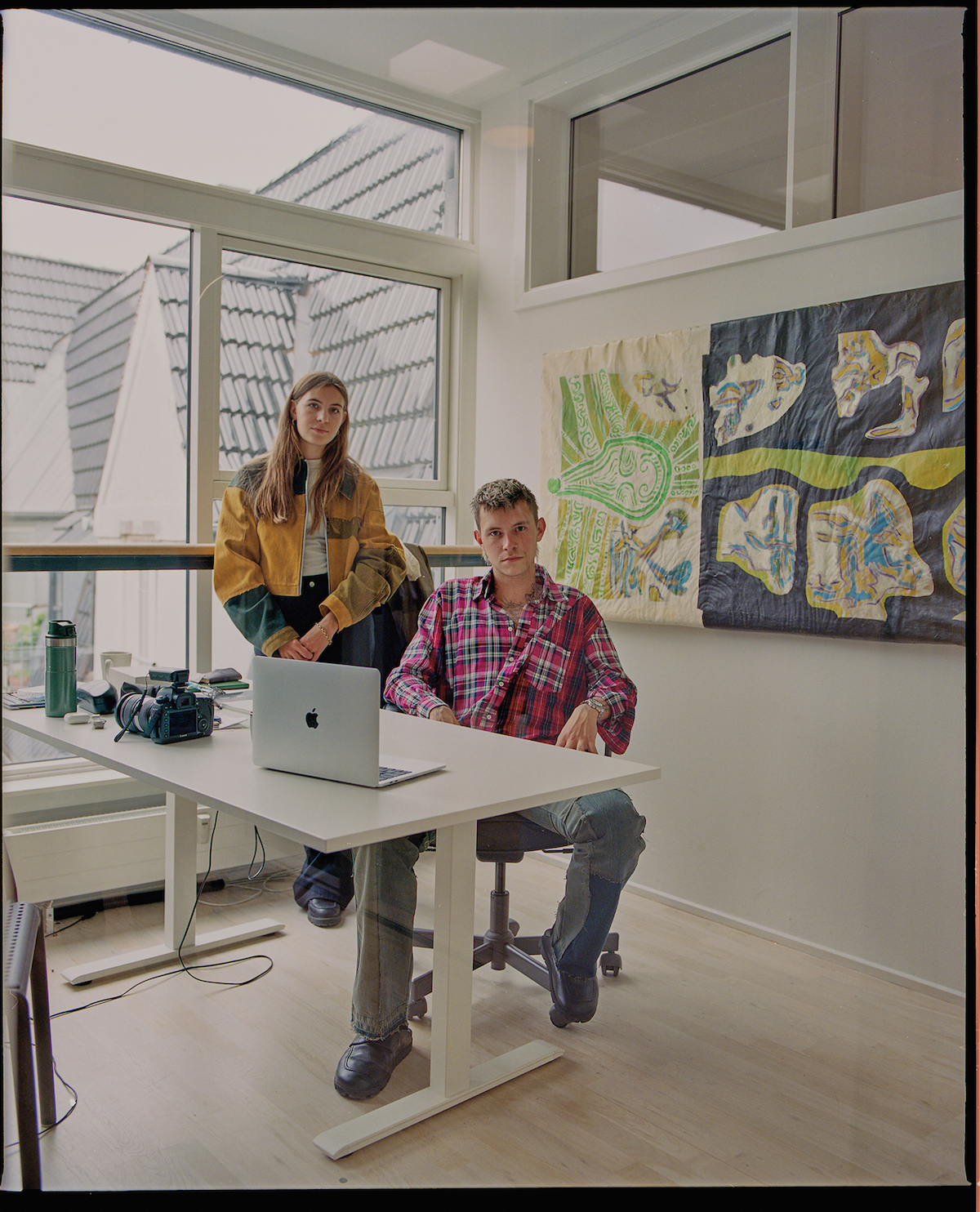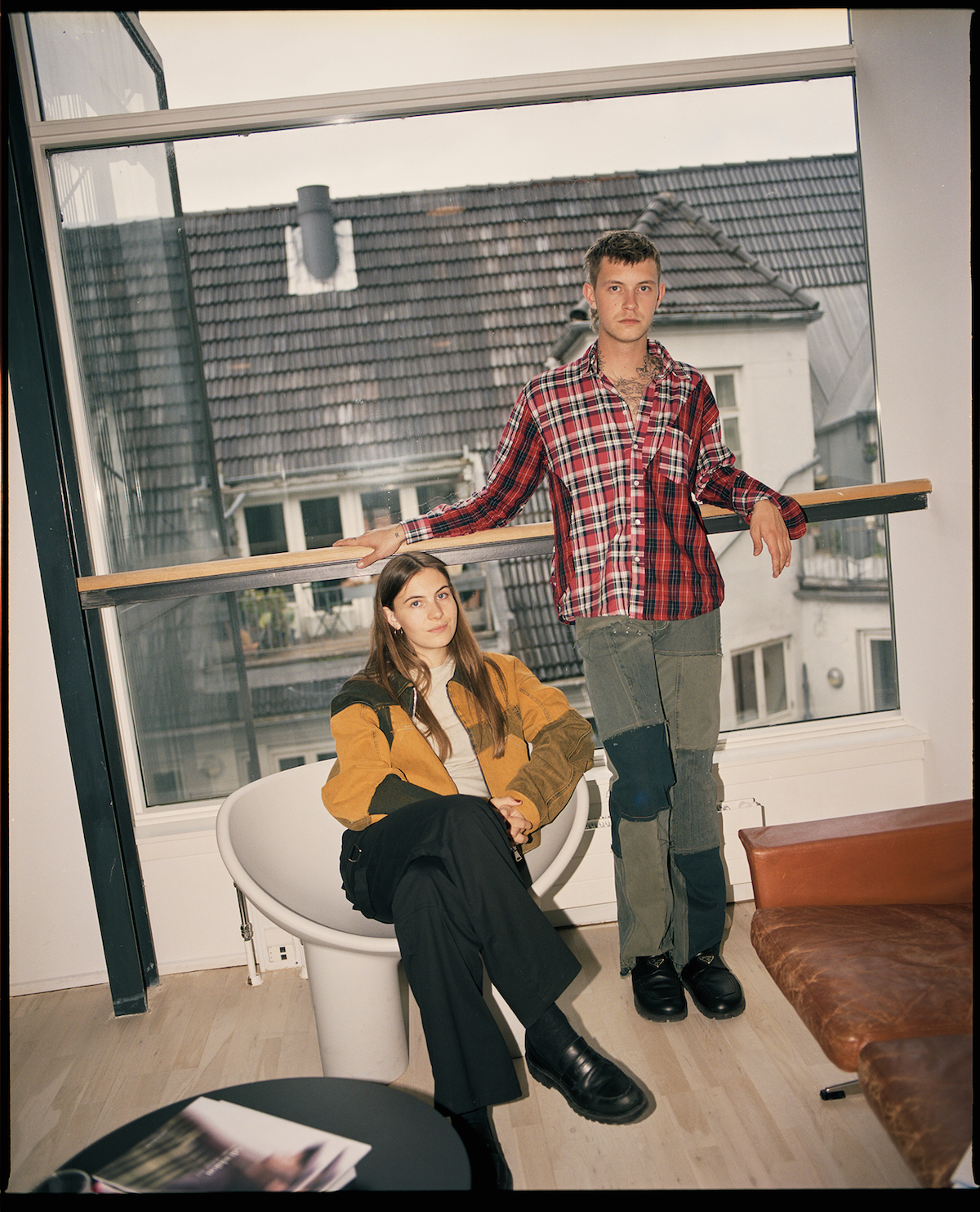New Guards of the Nordic: (DI)Vision
Meet Fashion’s Boldest Upcyclists

“Back when we first started, (di)vision was much more of a concept rather than a brand. We both wanted to challenge the traditional way of producing clothes. ‘Creating from what already is’ has always been our go-to work ethic,” explains Simon and Nanna Wick, the founders of one of Copenhagen’s brightest brands to date. A fashion house led primarily by environmental responsibility, the brother-sister design duo’s concentration on the usage of deadstock fabrics has led the brand to where it is today: a pioneering force in the reimagining of sustainable fashion.
“It was a no-brainer for both of us that we had to do clothing in a more responsible way, otherwise it wouldn’t make sense to put more brands into the world,” explains Simon. “Working with deadstock fabrics gives a more unpredictable touch to the brand. When we design a collection, we don’t know what is available until we source the fabrics.” Now a regular at Copenhagen Fashion Week and worn by celebrities such as Kendall Jenner, it’s been a full-circle journey from childhood to the atelier—as Nanna explains, “I never thought any of us would’ve imagined working together and building a brand 10 years later.”

Discover an extended Q+A with the design duo and VMAN’s Digital & Beauty Editor Kevin Ponce, below!
VMAN: Being a sibling duo, could you describe what your childhood was like? Were you both inclined to work in fashion?
Nanna Wick: I think we’ve always shared a lot of the same interests, whether it was music or playing video games, we’ve somehow managed to do a lot of these things together while growing up and both enjoyed being able to spend so much time with each other. I think my interest in fashion sprung from videogames and Simon later got really into streetwear, but I never think any of us would’ve imagined working together and building a brand 10 years later.
VM: Walk us through the beginning stage of the brand: what did the first few collections look like? How did the brand first come to be?
NW: Our very first product was our split bomber jacket. We released it in one colorway and then just evolved the product from there. We still make the bomber jacket and I think we are about to hit the 50th edition soon. For a really long time, we only worked reworking clothes, rather than producing them from new. Just like with the split bomber jacket, we kept to the split design for quite a while. This was easier for us and cheaper, as we were pretty broke. We quickly began to experiment and started working clothes from military surplus and later deadstock fabrics.
VM: When first started, what was the initial meaning behind the brand? Why did you both feel the need to create a label?
NW: Back when we first started, (di)vision was much more of a concept rather than a brand. We both wanted to challenge the traditional way of producing clothes and “creating from what already is”, has always been our go-to work ethic and most of our collections are made from pre-existing materials. While we were busy working on refining the concept of (di)vision, the brand slowly manifested itself. We sometimes still can’t believe how much (di)vision has grown since we first started and that we get to go on this adventure together.
VM: What do you think the label has to offer that separates itself from others?

Simon Wick: Hmm that’s a good question. I think (di)vision firstly has a very genuine feeling towards it. We have always tried to be very transparent in everything we do and never tried to be something that we are not. Also working with deadstock fabrics and creative production the way that we do has a more unpredictable touch to the brand. The fabrics, colors, etc. are often very different from season to season, due to the nature of deadstock fabrics. When we design a collection we don’t what is available until we source the fabrics. We can have some ideas, but if there is no fabric available that looks like that idea, we have to go another way. And we don’t take ourselves too seriously, we know that in the end, we are just making clothes. I think that honesty separates us from many other brands.
VM: Is there a reflection of Scandinavian fashion + the attitude of the region that you feel is represented in the clothes?
SW: Scandinavian fashion is often represented by a lot of minimalism and clean simple silhouettes. And I think we represent the exact opposite in many ways, with colorful and playful styles. But there are still a lot of Scandinavian references in our clothes. For example, the way that we use a zipper throughout the back as branding, instead of working with logos. I have never been a big fan of logos on clothing, so we like to work with cuts, silhouettes, colors, hardware, etc. to use as branding. Something I think is very common for a lot of Scandinavian brands. Also, we do a lot of outerwear because it’s always cold up here. For us, our signature bomber jacket is a product you can use all year around. Always when we are done designing a collection we look at everything and be like “Do we really need 25 jackets out of 60 styles.?” And then we have to sort them out. I think it’s where we feel the most comfortable because it’s such a big part of our wardrobe.
VM: I’ve read that the ideology of the brand is “creating from what already is”. and that in turn leads to your sustainable practices. Why was this of importance for both of you when starting the label?
SW: When starting the brand 2019, it was a no-brainer for both of us that we had to do clothing in a more responsible way, otherwise it wouldn’t make sense to put more brands into the world. I don’t think I need to explain to people, why the fashion industry is one of the most polluting industries in the world. But I can tell you how we decided to launch a brand under these circumstances and how we try to work around it. Nanna had her BA in fashion design but didn’t have any experience in production or how to make clothes on a larger scale and I didn’t have any formal education. Which meant that we had no idea how to scale a brand from a sample and idea to something we could actually sell to more people. This might be a big problem if you want to create a clothing label. But we tried to take the ignorance and turn it in our favor. For example, our first products were sourced from surplus military jackets that we would remake and then upcycled in Denmark. And we did pretty big quantities of them, something most people would have told us would be impossible. We have continued with these experimenting ways of producing and finding creative solutions for typical production, because we still have a lot of ignorance towards typical fashion production, and I think that comes in very handy for us. Of course, we have gotten much better at everything now, but having gone through so many different solutions, we have opened our minds to what the future of fashion could look like if we try some different ideas out. If we have to do it, then we have to do it the right way or at least try the best we can.
VM: Do you find it challenging to work with the limitations of using deadstock fabric and already existing materials to create new collections?
SW: The simple answer to this question would be “yes” haha. The biggest challenge working with the limitations of deadstock and already existing materials is always the quantities. When you are a smaller brand, you of course produce smaller quantities, but as you grow as a brand the quantities will grow. For example, If we find this amazing deadstock canvas fabric for a jacket (you need 2 meters to produce 1 jacket) and there are only 200 meters of the fabric available then we can only produce 100, well what do we do if we sell 150? This was fine when we could only sell 50 jackets, but now that we grow we can see it becoming more of a challenge. As followed by my last answer, we always look for new solutions and we have found many great solutions for this. We work closely with our suppliers, factories, and partners to challenge the traditional ways of fashion. We are not saints either, and some of the products that we do are not made from pre-existing materials, this includes our hats and some jersey. But it’s of course something we want to change, we just haven’t found the right solution yet. As we grow as a brand, the solutions for more responsible production have also grown. All of our partners are happier to take chances with us now to create new solutions, as they know just as much as us this is how the future looks like.
Discover More
